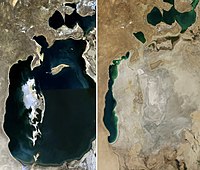
Photo from wikipedia
Inspired by the challenges of environmental change and the resource limitations experienced by modern society, recent decades have seen an increased interest in understanding the collapse of past societies. Modelling… Click to show full abstract
Inspired by the challenges of environmental change and the resource limitations experienced by modern society, recent decades have seen an increased interest in understanding the collapse of past societies. Modelling efforts so far have focused on single, isolated societies, while multi-patch dynamical models representing networks of coupled socio-environmental systems have received limited attention. We propose a model of societal evolution that describes the dynamics of a population that harvests renewable resources and manufactures products that have positive effects on population growth. Collapse is driven by a critical transition that occurs when the rate of natural resource extraction passes beyond a certain point, for which we present numerical and analytical results. Applying the model to Easter Island gives a good fit to the archaeological record. Subsequently, we investigate what effects emerge from the movement of people, goods, and resources between two societies that share the characteristics of Easter Island. We analyse how diffusive coupling and wealth-driven coupling change the population levels and their distribution across the two societies compared to non-interacting societies. We find that the region of parameter space in which societies can stably survive in the long-term is significantly enlarged when coupling occurs in both social and environmental variables.
Journal Title: Ecological Economics
Year Published: 2017
Link to full text (if available)
Share on Social Media: Sign Up to like & get
recommendations!